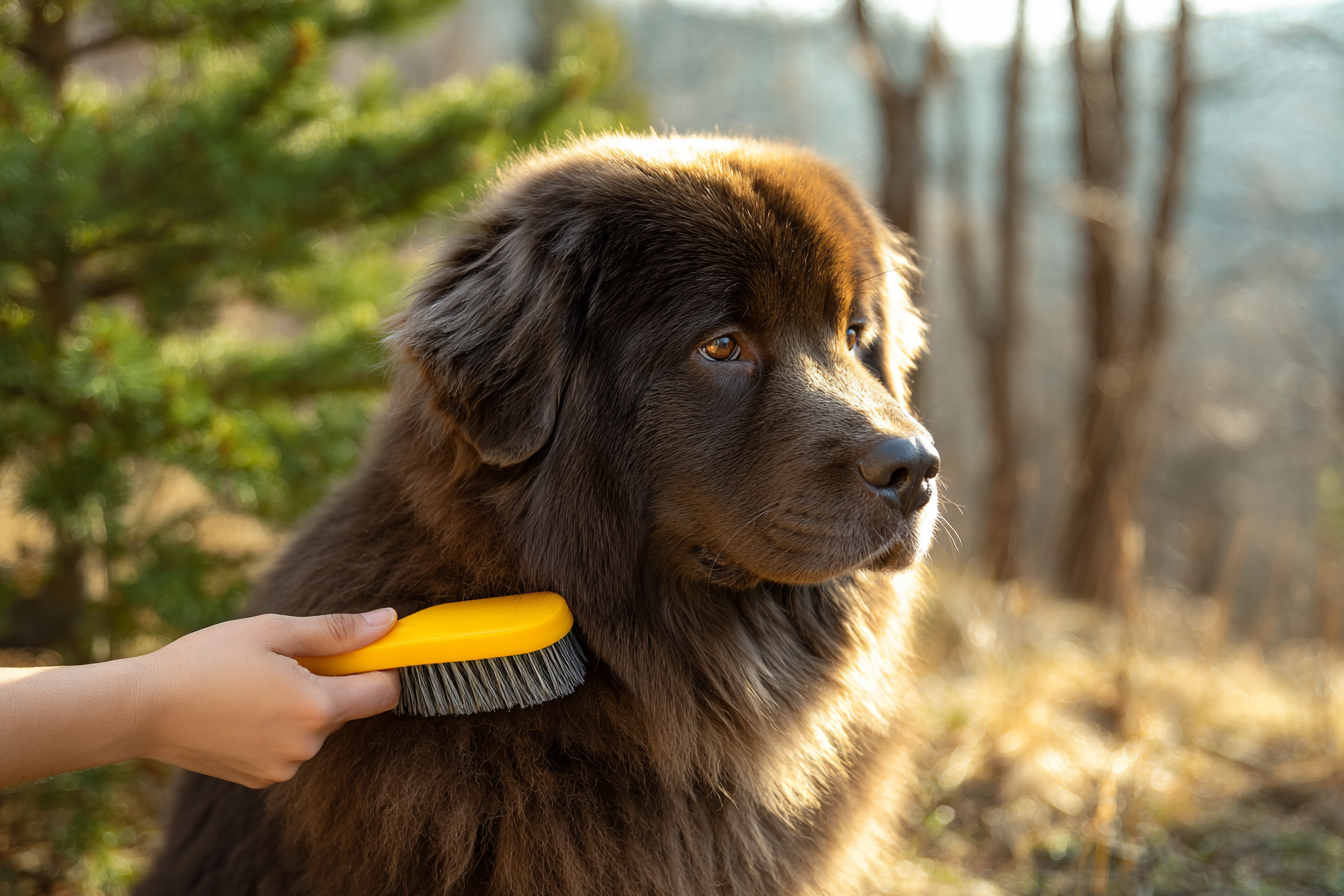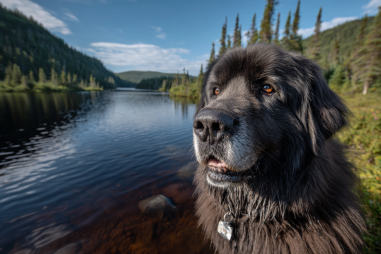Newfoundland dogs are known for their enormous size, gentle nature, and most notably, their thick, water-resistant double coat that protects them in cold weather. Grooming these gentle giants can be a rewarding experience, but it demands dedication and the right techniques to keep their coats healthy and looking magnificent. Whether you’re a new Newfoundland owner or looking to improve your grooming routine, this guide will walk you through everything you need to keep your furry friend clean, comfortable, and beautiful.
Understanding the Newfoundland Coat
The Newfoundland dog sports a dense double coat, consisting of a soft undercoat and a coarse outer coat. This unique combination is designed to provide insulation and repel water, which is essential given their history as water rescue dogs. The undercoat is thick and fluffy, while the topcoat is longer and oily, helping to protect against rain and snow.
Because of this double-layer design, grooming a Newfoundland requires special attention to both layers to prevent matting and skin issues. Neglecting regular grooming can lead to tangles in the undercoat that trap dirt and moisture, resulting in discomfort or even infections. Understanding the coat’s makeup is the first step in maintaining your Newfoundland’s signature look.
Daily and Weekly Grooming Routines
Daily brushing is ideal for Newfoundland dogs to prevent mats and tangles from forming, particularly if they spend time outdoors or shed heavily. At minimum, aim to brush your dog 3-4 times per week. Use long, sweeping strokes to work through their thick coat without scratching the skin underneath.
Here’s a simple grooming routine for Newfoundlands:
- Daily/Every other day: Use a slicker brush or a wide-toothed comb to check for tangles and remove loose hair, especially around behind the ears, under the legs, and by the collar area where mats tend to form.
- Weekly: Go over the entire coat with an undercoat rake or de-shedding tool to remove dead undercoat fur, which helps reduce shedding and keeps the coat healthier.
- Check ears and teeth: Look inside the ears for dirt or signs of infection and brush your dog’s teeth to prevent dental problems.
Consistency is key, and making grooming a positive and calm experience can help your Newfoundland look forward to these bonding moments.
Bathing Tips and Frequency
Newfoundlands do not need frequent baths; bathing them about once every 6-8 weeks is generally sufficient unless they get particularly dirty. Too frequent baths can strip the natural oils from their coat, which are important for water resistance and skin health.
When it’s time for a bath, choose a gentle dog shampoo formulated for sensitive skin. Follow these steps for the best results:
- Brush the coat thoroughly before bathing to remove mats and loose fur.
- Use lukewarm water and thoroughly wet the coat, making sure to reach the undercoat.
- Apply shampoo, work it into a rich lather, and gently massage the skin to clean well without causing irritation.
- Rinse completely; leftover shampoo can cause itching and dryness.
- After bathing, use a microfiber towel or a high-absorbency drying towel to remove excess water before using a blow dryer on a low, cool setting to dry the coat fully. This helps prevent dampness which can lead to skin infections.
Bathing may also be needed more often during shedding seasons or if your Newfoundland spends a lot of time outdoors in muddy or wet environments.
Nail, Teeth, and Ear Care
Grooming doesn’t stop at the coat. Maintaining your Newfoundland’s nails, teeth, and ears is vital for overall health:
- Nail care: Check nails every 2-3 weeks. Long nails can cause discomfort and affect your dog’s gait. Use a dog nail clipper or grinder, and be careful to avoid cutting the quick, which is painful and bleeds.
- Teeth cleaning: Brush teeth at least 2-3 times a week with canine-specific toothpaste. Good dental care helps prevent bad breath, gum disease, and tooth loss.
- Ear care: Newfoundlands have floppy ears that can trap moisture and dirt, making infections more likely. Clean ears weekly using a vet-recommended ear cleaner and cotton balls. Avoid inserting anything deep into the ear canal.
Seasonal Grooming Considerations
Seasonal changes affect your Newfoundland’s grooming needs significantly. Spring and fall are particularly important as Newfoundlands shed their heavy undercoats to adjust to temperature changes.
- During heavy shedding seasons, increase brushing frequency to daily sessions to remove loose fur and prevent mats.
- Consider using an undercoat rake or specialized deshedding tool to manage the thick fur shed during these times.
- In summer, keep an eye on overheating risks. While Newfoundlands tolerate cold well, their thick coat can cause heat stress, so regular grooming helps improve air circulation through the coat.
- Winter grooming should ensure the coat thickness remains intact for protection against harsh weather, so avoid shaving or thinning the coat excessively.
Dealing with Shedding
Newfoundlands are moderate to heavy shedders all year round, with noticeable increases twice a year. Managing shedding is a combination of regular grooming, proper nutrition, and ensuring your dog’s health is optimal.
Here are tips to reduce shedding around your home:
- Brush frequently using a slicker brush and undercoat rake to catch loose hair before it falls.
- Use high-quality, balanced dog food rich in omega fatty acids to support a healthy coat.
- Consider supplements after consulting your vet to improve skin and coat condition.
- Regular baths with moisturizing shampoos can help reduce dry skin and shedding.
Tools and Products Recommended
Having the right tools can make grooming your Newfoundland easier and more effective. Here’s a list of essentials:
- Slicker brush: Great for removing surface debris and detangling.
- Undercoat rake: Helps remove loose undercoat fur and reduce matting.
- Wide-toothed comb: For gently smoothing the fur and detecting mats.
- De-shedding tool: Useful during shedding seasons to manage heavy fur loss.
- High-quality dog shampoo and conditioner: For gentle cleansing and coat nourishment.
- Dog nail clippers or grinder: For safe nail trims.
- Dog ear cleaner: Helps maintain ear hygiene.
- Dog toothpaste and toothbrush: For dental care.
- Absorbent towels and a cool blow dryer: To thoroughly dry the coat after baths.
Choosing tools designed specifically for large, thick-coated dogs will make the grooming process less stressful for both you and your Newfoundland.
Cherishing Your Gentle Giant
Grooming your Newfoundland is more than just maintaining their stunning coat—it’s about keeping them comfortable, healthy, and happy. With patience, regular care, and the right tools, grooming can become an enjoyable bonding activity. Remember, these gentle giants rely on you to keep their massive, beautiful fur in tip-top shape, so a little commitment goes a long way in ensuring your Newfoundland looks and feels their very best.







